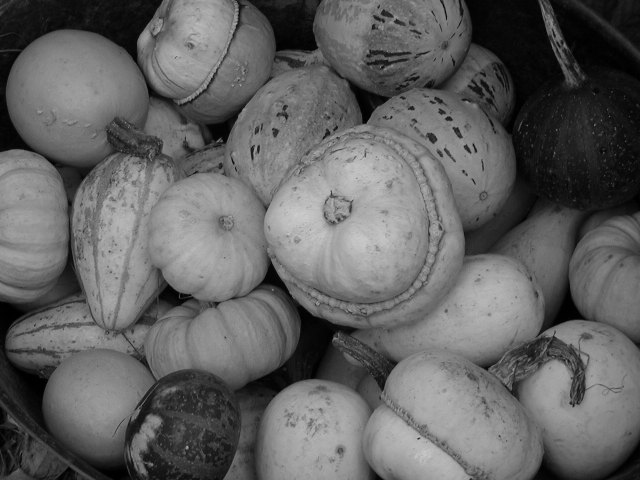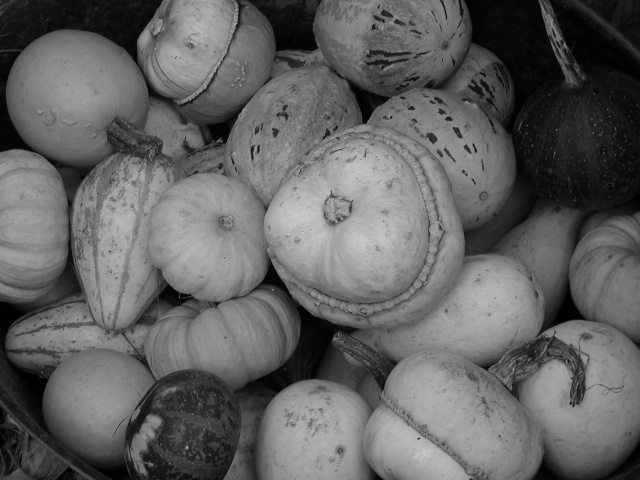Convert File Formats#
Synopsis#
Convert from one image file format to another. ITK will automatically detect the file type of the input and output files by their extension, and an itk::ImageFileReader and itk::ImageFileWriter will use the appropriate ImageIO class.
Results#

Gourds.png#

Gourds.jpg#
Code#
C++#
#include "itkImageFileReader.h"
#include "itkImageFileWriter.h"
int
main(int argc, char * argv[])
{
if (argc != 3)
{
std::cerr << "Usage: " << std::endl;
std::cerr << argv[0];
std::cerr << "<InputFileName> <OutputFileName>";
std::cerr << std::endl;
return EXIT_FAILURE;
}
constexpr unsigned int Dimension = 2;
using PixelType = unsigned char;
using ImageType = itk::Image<PixelType, Dimension>;
const auto input = itk::ReadImage<ImageType>(argv[1]);
try
{
itk::WriteImage(input, argv[2]);
}
catch (const itk::ExceptionObject & error)
{
std::cerr << "Error: " << error << std::endl;
return EXIT_FAILURE;
}
return EXIT_SUCCESS;
}
Classes demonstrated#
-
template<typename TOutputImage, typename ConvertPixelTraits = DefaultConvertPixelTraits<typename TOutputImage::IOPixelType>>
class ImageFileReader : public itk::ImageSource<TOutputImage> Data source that reads image data from a single file.
This source object is a general filter to read data from a variety of file formats. It works with a ImageIOBase subclass to actually do the reading of the data. Object factory machinery can be used to automatically create the ImageIOBase, or the ImageIOBase can be manually created and set. Note that this class reads data from a single file; if you wish to read data from a series of files use ImageSeriesReader.
TOutputImage is the type expected by the external users of the filter. If data stored in the file is stored in a different format then specified by TOutputImage, than this filter converts data between the file type and the external expected type. The
ConvertPixelTraitstemplate parameter is used to do the conversion.A Pluggable factory pattern is used this allows different kinds of readers to be registered (even at run time) without having to modify the code in this class. Normally just setting the FileName with the appropriate suffix is enough to get the reader to instantiate the correct ImageIO and read the file properly. However, some files (like raw binary format) have no accepted suffix, so you will have to manually create the ImageIO instance of the write type.
- See
ImageSeriesReader
- See
ImageIOBase
- ITK Sphinx Examples:
-
template<typename TInputImage>
class ImageFileWriter : public itk::ProcessObject Writes image data to a single file.
ImageFileWriter writes its input data to a single output file. ImageFileWriter interfaces with an ImageIO class to write out the data. If you wish to write data into a series of files (e.g., a slice per file) use ImageSeriesWriter.
A pluggable factory pattern is used that allows different kinds of writers to be registered (even at run time) without having to modify the code in this class. You can either manually instantiate the ImageIO object and associate it with the ImageFileWriter, or let the class figure it out from the extension. Normally just setting the filename with a suitable suffix (“.png”, “.jpg”, etc) and setting the input to the writer is enough to get the writer to work properly.
- See
ImageSeriesReader
- See
ImageIOBase
- ITK Sphinx Examples:
